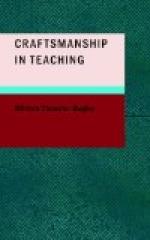III
The unsatisfactory character of these three values that have been proposed for history—the utilitarian, the disciplinary, and the cultural—is typical of the values that have been proposed for other subjects. Unless the aim of teaching any given subject can be stated in definite terms, the teacher must work very largely in the dark; his efforts must be largely of the “hit-or-miss” order. The desired value may be realized under these conditions, but, if it is realized, it is manifestly through accident, not through intelligent design. It is needless to point out the waste that such a blundering and haphazard adjustment entails. We all know how much of our teaching fails to hit the mark, even when we are clear concerning the result that we desire; we can only conjecture how much of the remainder fails of effect because we are hazy and obscure concerning its purpose.
Let us return to our original basic principle and see what light it may throw upon our problem. We have said that the efficiency of teaching must always be measured by the degree in which the pupil’s conduct is modified. Taking conduct as our base, then, let us reason back and see what factors control conduct, and, if possible, how these “controls” may be influenced by the processes of education working through the lesson in history.
I shall start with a very simple and apparently trivial example. When I was living in the Far West, I came to know something of the Chinese, who are largely engaged, as you know, in domestic service in that part of the country. Most of the Chinese servants that I met corresponded very closely with what we read concerning Chinese character. We have all heard of the Chinese servant’s unswerving adherence to a routine that he has once established. They say in the West that when a housewife gives her Chinese servant an object lesson in the preparation of a certain dish, she must always be very careful to make her demonstration perfect the first time. If, inadvertently, she adds one egg too many, she will find that, in spite of her protestations, the superfluous egg will always go into that preparation forever afterward. From what I know of the typical Oriental, I am sure that this warning is not overdrawn.
Now here is a bit of conduct, a bit of adjustment, that characterizes the Chinese cook. Not only that, but, in a general way, it is peculiar to all Chinese, and hence may be called a national trait. We might call it a vigorous national prejudice in favor of precedent. But whatever we call it, it is a very dominant force in Chinese life. It is the trait that, perhaps more than any other, distinguishes Chinese conduct from European or American conduct. Now one might think this trait to be instinctive,—to be bred in the bone rather than acquired,—but this I am convinced is not altogether true. At least one Chinese whom I knew did not possess it at




